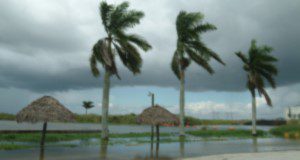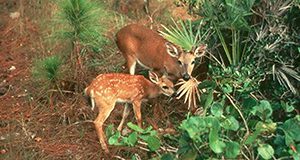Climate change is considered one of the biggest challenges facing society. As global temperatures continue to rise, we are threatened by melting ice sheets, rising sea levels, and extreme weather events. Climate change is also something that the people in south Florida live with daily. Still, the science of climate change is complicated, leaving many in the region looking for trusted information about why climate should matter to them. The purpose of this new 8-page FAQ document is to provide answers to commonly asked questions regarding climate change. The questions come from south Florida residents and municipal workers concerned with the climate outcomes to their region. The FAQ address several areas of concerns, including the basic science behind climate change, the projected impacts to residents of south Florida, and actions that individuals can take to reduce their carbon footprints. Written by Joshua Papacek, Ashley Smyth, Holly Abeels, and Alicia Betancourt, and published by the UF/IFAS Department of Soil and Water Sciences.
https://edis.ifas.ufl.edu/ss682
Tag: Climate Change
Climate Changes, Shifting Ranges: Climate change effects on wildlife in the Florida Everglades and Keys
Where do the animals go when the sea rises? Learn the probable futures of Florida panthers and other south Florida wildlife in this 5-page fact sheet. Written by Larry Perez, James I. Watling, David Bucklin, Mathieu Basille, Frank J. Mazzotti, Stephanie Romañach, and Laura Brandt and published by the UF Department of Wildlife Ecology and Conservation, it explains how a changing climate could impact wild animals.
edis.ifas.ufl.edu/uw428
Climate Change: Effects on Salinity in Florida's Estuaries and Responses of Oysters, Seagrass, and Other Biota
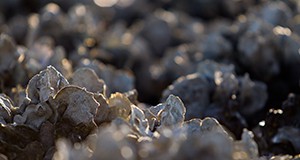 Florida’s economically important estuaries could be heavily impacted by sea-level rise and altered river flow, both caused by climate change. The resulting higher salinity, or saltiness of the water, could harm plants and animals, alter fish and bird habitat, and reduce the capacity of estuaries to provide such important services as seafood production and the protection of shorelines from erosion. This 6-page fact sheet explains the importance of estuaries, salinity in estuaries, and provides examples of stress from extreme high salinity. Then it explores the projected change in climate that could affect salinity in estuaries, how plants and animals would be affected, mitigating effects, and other impacts of climate change on estuaries. Written by Karl Havens, and published by the UF Department of Sea Grant, June 2015.
Florida’s economically important estuaries could be heavily impacted by sea-level rise and altered river flow, both caused by climate change. The resulting higher salinity, or saltiness of the water, could harm plants and animals, alter fish and bird habitat, and reduce the capacity of estuaries to provide such important services as seafood production and the protection of shorelines from erosion. This 6-page fact sheet explains the importance of estuaries, salinity in estuaries, and provides examples of stress from extreme high salinity. Then it explores the projected change in climate that could affect salinity in estuaries, how plants and animals would be affected, mitigating effects, and other impacts of climate change on estuaries. Written by Karl Havens, and published by the UF Department of Sea Grant, June 2015.
http://edis.ifas.ufl.edu/sg138
Climate Change and Ecosystem Services of Florida's Largest Water Body: Lake Okeechobee
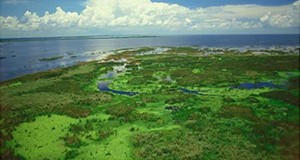 Future climate change could result in higher temperatures and greater evaporative water loss in Florida. If these changes are not compensated for by more rainfall, the state’s largest water body, Lake Okeechobee, could experience prolonged periods of very low water levels and catastrophic loss of its ecosystem services, which are the benefits that people receive from ecosystems. This 6-page fact sheet provides background, optimal and actual water levels, projected changes in South Florida climate & their effects on water levels in Lake Okeechobee, their effects on ecosystem services, and possible remedies. Written by Karl Havens, and published by the UF Department of Sea Grant, June 2015.
Future climate change could result in higher temperatures and greater evaporative water loss in Florida. If these changes are not compensated for by more rainfall, the state’s largest water body, Lake Okeechobee, could experience prolonged periods of very low water levels and catastrophic loss of its ecosystem services, which are the benefits that people receive from ecosystems. This 6-page fact sheet provides background, optimal and actual water levels, projected changes in South Florida climate & their effects on water levels in Lake Okeechobee, their effects on ecosystem services, and possible remedies. Written by Karl Havens, and published by the UF Department of Sea Grant, June 2015.
http://edis.ifas.ufl.edu/sg137
Climate Change and the Occurrence of Harmful Microorganisms in Florida's Ocean and Coastal Waters
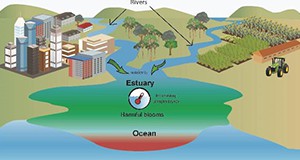 Climate change is expected to result in increased temperatures of nearshore ocean water, and this could lead to increased growth of harmful microorganisms. These include algae that form noxious or toxic blooms, including red tides, and bacteria and other pathogens. This situation could have negative consequences in regard to human health and also Florida’s ocean-related economy. This 6-page fact sheet discusses projected ocean temperatures, how harmful microorganisms living in the ocean might respond, and how this might affect people, and identifies actions that could be taken to reduce these impacts. Written by Karl Havens, and published by Florida Sea Grant, June 2015.
Climate change is expected to result in increased temperatures of nearshore ocean water, and this could lead to increased growth of harmful microorganisms. These include algae that form noxious or toxic blooms, including red tides, and bacteria and other pathogens. This situation could have negative consequences in regard to human health and also Florida’s ocean-related economy. This 6-page fact sheet discusses projected ocean temperatures, how harmful microorganisms living in the ocean might respond, and how this might affect people, and identifies actions that could be taken to reduce these impacts. Written by Karl Havens, and published by Florida Sea Grant, June 2015.
http://edis.ifas.ufl.edu/sg136
Some Challenges behind Communicating about Climate Change
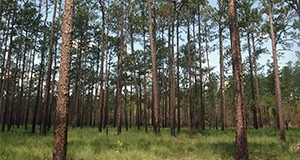 Media coverage of climate change can often leave the average person confused and unsure what to believe. However, as a trusted source of information and research, Extension has the opportunity to educate people about climate change and appropriate adaptation strategies in a scientific, unbiased way. This 5-page fact sheet outlines four challenges of climate change education. Written by Martha Monroe, Claire Layman Bode, and Mark A. Megalos, and published by the UF School of Forest Resources and Conservation, May 2015.
Media coverage of climate change can often leave the average person confused and unsure what to believe. However, as a trusted source of information and research, Extension has the opportunity to educate people about climate change and appropriate adaptation strategies in a scientific, unbiased way. This 5-page fact sheet outlines four challenges of climate change education. Written by Martha Monroe, Claire Layman Bode, and Mark A. Megalos, and published by the UF School of Forest Resources and Conservation, May 2015.
http://edis.ifas.ufl.edu/fr392
An Overview of Carbon Markets for Florida Forest Landowners
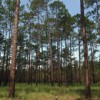 Payments for sequestering carbon in forests can be an important supplemental income source in the southern US which includes one-third of the contiguous US forest carbon stocks and supplies 16% of the world’s wood. It is difficult to understand the carbon market and certification options available to Florida forest landowners and the possible risks of participating in them. To address this need, UF/IFAS forest management specialists provide this overview of forest carbon markets in the United States as of 2014 and compare key features of the four major carbon offset certification options. This 9-page fact sheet was written by José R. Soto, Francisco J. Escobedo, and Damian C. Adams, and published by the UF Department of School of Forest Resources and Conservation, July 2014.
Payments for sequestering carbon in forests can be an important supplemental income source in the southern US which includes one-third of the contiguous US forest carbon stocks and supplies 16% of the world’s wood. It is difficult to understand the carbon market and certification options available to Florida forest landowners and the possible risks of participating in them. To address this need, UF/IFAS forest management specialists provide this overview of forest carbon markets in the United States as of 2014 and compare key features of the four major carbon offset certification options. This 9-page fact sheet was written by José R. Soto, Francisco J. Escobedo, and Damian C. Adams, and published by the UF Department of School of Forest Resources and Conservation, July 2014.
http://edis.ifas.ufl.edu/fr387
Florida Forest Landowner Preferences for Carbon Offset Program Characteristics
 This 7-page fact sheet explains how carbon-offset programs operate and examines their benefits to landowners and the environment, especially in Florida and the southeast US. A summary of a recent study of Florida forest landowners is used to better reveal views on forest carbon-offset programs and their willingness-to-accept monetary compensation for their enrollment in such programs. Written by José R. Soto, Damian C. Adams, and Francisco J. Escobedo, and published by the UF Department of School of Forest Resources and Conservation, July 2014.
This 7-page fact sheet explains how carbon-offset programs operate and examines their benefits to landowners and the environment, especially in Florida and the southeast US. A summary of a recent study of Florida forest landowners is used to better reveal views on forest carbon-offset programs and their willingness-to-accept monetary compensation for their enrollment in such programs. Written by José R. Soto, Damian C. Adams, and Francisco J. Escobedo, and published by the UF Department of School of Forest Resources and Conservation, July 2014.
http://edis.ifas.ufl.edu/fr388
The Potential of Sea-level Rise on Florida’s Coastal Ecosystems
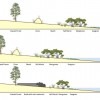 Sea-level rise may have significant effects on Florida’s coastal ecosystems. These ecosystems are the foundation upon which much of Florida’s natural beauty and economy are based. Understanding what changes may happen in the future can help us plan for those changes and, to the extent possible, lessen the impacts of those changes. This 5-page fact sheet was written by Whitney Gray, and published by the UF Department of Sea Grant, October 2013.
Sea-level rise may have significant effects on Florida’s coastal ecosystems. These ecosystems are the foundation upon which much of Florida’s natural beauty and economy are based. Understanding what changes may happen in the future can help us plan for those changes and, to the extent possible, lessen the impacts of those changes. This 5-page fact sheet was written by Whitney Gray, and published by the UF Department of Sea Grant, October 2013.
http://edis.ifas.ufl.edu/sg131
Conserving Urban Wildlife in the Face of Climate Change
 Virtually all climatologists agree that humans are increasing the rate of the Earth’s warming by releasing greenhouse gases into the atmosphere. But you might be surprised to learn that houses and residential neighborhoods are sources greenhouse gases of carbon because everything in a house that runs on electricity or gas is often derived from burning fossil fuels. This 4-page fact sheet describes the connections between climate change, wildlife, and human neighborhoods and presents several ways for residents to live more sustainably. Written by Daniel Feinberg and Mark Hostetler, and published by the UF Department of Wildlife Ecology and Conservation, September 2013.
Virtually all climatologists agree that humans are increasing the rate of the Earth’s warming by releasing greenhouse gases into the atmosphere. But you might be surprised to learn that houses and residential neighborhoods are sources greenhouse gases of carbon because everything in a house that runs on electricity or gas is often derived from burning fossil fuels. This 4-page fact sheet describes the connections between climate change, wildlife, and human neighborhoods and presents several ways for residents to live more sustainably. Written by Daniel Feinberg and Mark Hostetler, and published by the UF Department of Wildlife Ecology and Conservation, September 2013.
http://edis.ifas.ufl.edu/uw381
Effects of Climate Change on the Eutrophication of Lakes and Estuaries (SGEF189/SG127)
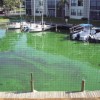 Recent research suggests that climate change will reinforce the negative consequences of man-made eutrophication and make it more difficult to improve water quality in lakes and estuaries.This 3-page fact sheet was written by Karl Havens, and published by the UF Department of Sea Grant, September 2012.
Recent research suggests that climate change will reinforce the negative consequences of man-made eutrophication and make it more difficult to improve water quality in lakes and estuaries.This 3-page fact sheet was written by Karl Havens, and published by the UF Department of Sea Grant, September 2012.
http://edis.ifas.ufl.edu/sg127
Climate Change Adaptation: New Perspectives for Natural Resource Management and Conservation (WEC318/UW363)
Climate change is creating new challenges for conservation and management of natural resources. As temperatures, rainfall patterns, and disturbance regimes change and sea levels rise, ecosystems are being transformed. With climate change species and communities may move out of the fixed systems in reserves that were established to protect them, and may not have the needed migration corridors to successfully disperse. The rate at which climate is projected to change in coming decades is likely too fast for many species to genetically adapt or to migrate to new suitable areas. Climate change underscores the need to transform our view of the natural world. While many of our conservation tools and approaches will stay the same, a new perspective will enable us to better apply these tools to meet future challenges. This 3-page fact sheet summarizes recommendations from four recent reviews of the literature on climate change adaptation. Written by Rebecca G. Harvey, Laura A. Brandt, and Frank J. Mazzotti, and published by the UF Department of Wildlife Ecology and Conservation, February 2012.
http://edis.ifas.ufl.edu/uw363
WEC286/UW331 Science Support for Climate Change Adaptation in South Florida
WEC286, a 5-page illustrated fact sheet by Laura M. Early, Rebecca G. Harvey, Laura A. Brandt, James I. Watling, and Frank J. Mazzotti, discusses how climate change will affect sea level and the ecosystem in South Florida and outlines the Department of Interior’s approach to manage public lands and natural resources impacted by climate change. Includes references. Published by the UF Department of Wildlife Ecology and Conservation, July 2010.
http://edis.ifas.ufl.edu/uw331
WEC282/UW327 Planning for Climate Change in South Florida: Climate Envelope Modeling for Threatened and Endangered Species
WEC282, a 3-page illustrated fact sheet by Laura A. Brandt, Stephanie S. Romañach and Frank J. Mazzotti, describes a project of the University of Florida, U.S. Fish and Wildlife Service, U.S. Geological Survey, and National Park Service to develop methods and tools that will allow natural resource managers to examine potential effects of climate change on species’ geographic ranges in the context of ecosystem and landscape planning in South Florida. Published by the UF Department of Wildlife Ecology and Conservation, May 2010.
http://edis.ifas.ufl.edu/uw327
FE787 Economic Impacts of Climate Change on Florida: Estimates from Two Studies
FE787, a 12-page fact sheet by Tatiana Borisova, Norman Breuer, and Roy Carriker, focuses on one piece of the policy-making puzzle related to climate change: possible economic costs for the state of Florida associated with climate change projections. Includes references. Published by the UF Department of Food and Resource Economics, December 2008.
http://edis.ifas.ufl.edu/FE787
AE435 Greenhouse Gas Mitigation in Forest and Agricultural Lands: Carbon Sequestration
AE435, an 8-page fact sheet by Solomon G. Haile, Clyde W. Fraisse, Vimala D. Nair, and P.K. Ramachandran Nair, addresses some basic questions regarding the prospects of carbon (C) sequestration in forest and agricultural lands and examines the C sequestration potential of different land management practices that could play a role in GHG mitigation strategies. Includes references. Published by the UF Department of Agricultural and Biological Engineering, September 2008.
http://edis.ifas.ufl.edu/AE435
